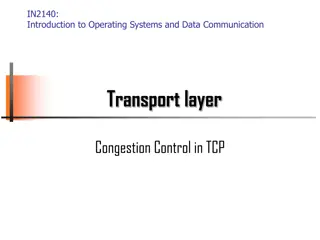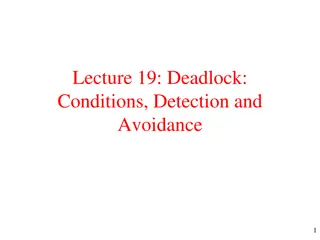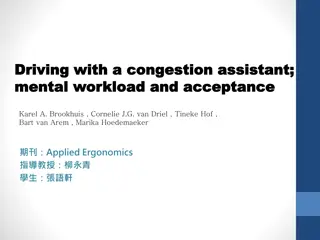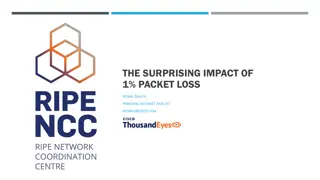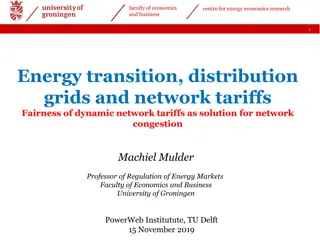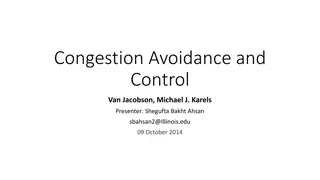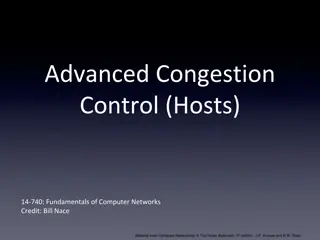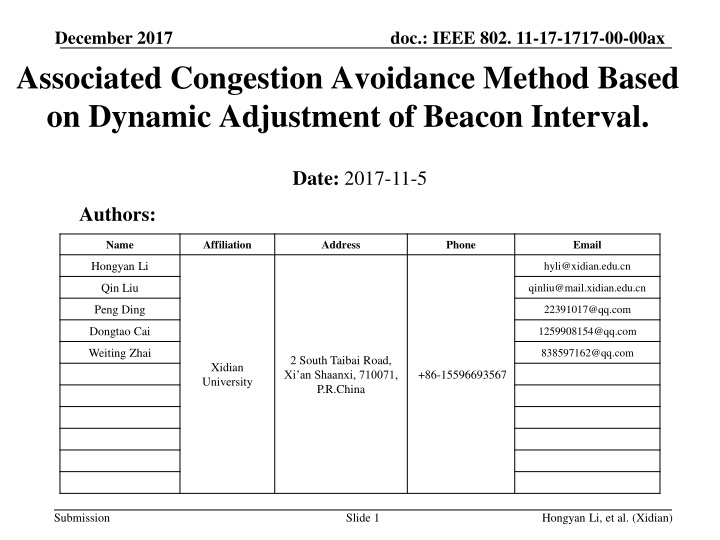
Dynamic Congestion Avoidance Method for WLAN Networks
"Learn about a congestion avoidance method for WLAN networks. The method involves dynamically adjusting beacon intervals to manage network congestion effectively, improving access success rates. Developed by Hongyan Li and team at Xidian University, this IEEE 802.11-17-1717-00-00ax document provides detailed steps for implementation and enhancement of network performance."
Uploaded on | 0 Views
Download Presentation

Please find below an Image/Link to download the presentation.
The content on the website is provided AS IS for your information and personal use only. It may not be sold, licensed, or shared on other websites without obtaining consent from the author. If you encounter any issues during the download, it is possible that the publisher has removed the file from their server.
You are allowed to download the files provided on this website for personal or commercial use, subject to the condition that they are used lawfully. All files are the property of their respective owners.
The content on the website is provided AS IS for your information and personal use only. It may not be sold, licensed, or shared on other websites without obtaining consent from the author.
E N D
Presentation Transcript
December 2017 Associated Congestion Avoidance Method Based on Dynamic Adjustment of Beacon Interval. doc.: IEEE 802. 11-17-1717-00-00ax Date: 2017-11-5 Authors: Name Affiliation Address Phone Email Hongyan Li hyli@xidian.edu.cn Qin Liu qinliu@mail.xidian.edu.cn Peng Ding 22391017@qq.com Dongtao Cai 1259908154@qq.com Weiting Zhai 838597162@qq.com 2 South Taibai Road, Xi an Shaanxi, 710071, P.R.China Xidian University +86-15596693567 Submission Slide 1 Hongyan Li, et al. (Xidian)
December 2017 doc.: IEEE 802. 11-17-1717-00-00ax Background The process of association and authentication is one of the core technologies of Wireless Local Area Networks(WLAN) Communication. In the infrastructure BSS network, the station must first be associated with the access point in order to obtain network services. However, when the number of stations is very large, there will be a large number of stations associated with an access point at the same time, which is likely to lead to network congestion, and the low access success rat. In this case, the usual solution is to manually modify the Beacon Interval time parameter by the administrator. Submission Slide 2 Hongyan Li, et al. (Xidian)
December 2017 Associated Congestion Avoidance Method Based on Dynamic Adjustment of Beacon Interval. doc.: IEEE 802. 11-17-1717-00-00ax Step 1: Set the timer and timer on AP side, new T T old respectively, to record the duration of Beacon Interval in next time and this time; Submission Slide 3 Hongyan Li, et al. (Xidian)
December 2017 Associated Congestion Avoidance Method Based on Dynamic Adjustment of Beacon Interval doc.: IEEE 802. 11-17-1717-00-00ax N Step 2: Set two counters and on the AP side, N old new respectively, to record the number of STA that associated with AP successful in this and the last Beacon Interval; Submission Slide 4 Hongyan Li, et al. (Xidian)
December 2017 Associated Congestion Avoidance Method Based on Dynamic Adjustment of Beacon Interval doc.: IEEE 802. 11-17-1717-00-00ax Step 3: At the end of each Beacon Interval, perform a dynamic N N N adjustment of Beacon Interval. Compare and .If < T (1 ) old k T + (1 ) old k T + = N new old old new , will be adjusted to , if , it will be adjusted new N N new old to . The dynamic adjustment expression is (1 (1 ) ) , , k T k T N N N N old new old T new old new old where, k is the adjustment factor and the value is from 0 to 0.1. Submission Slide 5 Hongyan Li, et al. (Xidian)
December 2017 Associated Congestion Avoidance Method Based on Dynamic Adjustment of Beacon Interval doc.: IEEE 802. 11-17-1717-00-00ax Step 4: After performing the dynamic adjustment of Beacon Interval, modify the AP-side parameter and adjust it as follows: = T T old new = N N old new Submission Slide 6 Hongyan Li, et al. (Xidian)
December 2017 doc.: IEEE 802. 11-17-1717-00-00ax Conclusion This method changes the association process, in which the Beacon Interval is a fixed value, and dynamically adjusts the value of the next Beacon Interval according to the difference between the two numbers of STAs that successfully associated with the AP in two Beacon Intervals, so that the number of the STAs that will associate with the AP can be increased in the next Beacon Interval. Submission Slide 7 Hongyan Li, et al. (Xidian)



